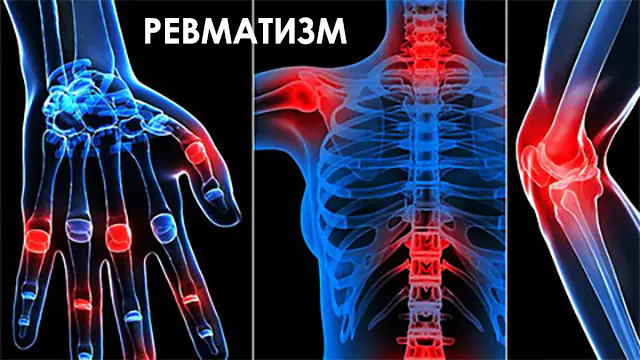
What is rheumatism, causes and symptoms of the disease. Stages and forms of articular rheumatism, diagnosis. Treatment of pathology in children and adults, folk remedies and prevention.
The content of the article:- What is rheumatism of the joints
- Reasons for development
- Main symptoms
- Diagnostic methods
- Treatment options
- Medicines
- Physiotherapy
- Folk remedies
- How to treat rheumatism in children
- Prevention measures
Rheumatism is an infectious pathology of connective tissue that often affects the heart and musculoskeletal system. The disease is accompanied by pain in the joints, changes in their shape and limited mobility. Along with the musculoskeletal system, heart valves are involved in the pathological process.
What is rheumatism of the joints?
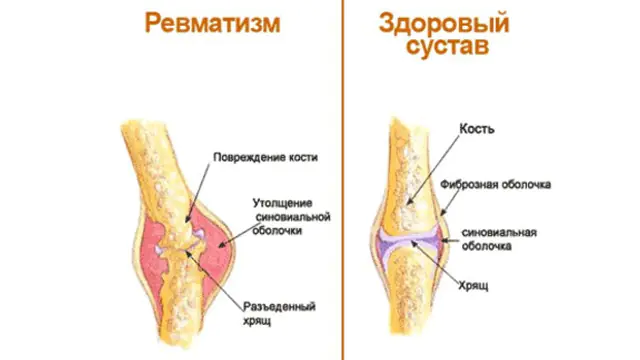
Rheumatism of the joints (rheumatic fever, rheumatic polyarthritis) is a disease discovered in the 19th century by Sokolsky-Buyo. The pathology is seasonal and worsens in spring and autumn. In addition to joints, the disease can affect the skin, blood vessels, and nervous system.
Important! Pathology destroys collagen, which makes up 60% of connective tissue.It is generally accepted that rheumatism is a pathology that affects older people. But statistics show that most often its victims are children from 7 to 11 years old. Rheumatism in adults develops up to 40 years of age. Women suffer from it 3 times more often than men. The overall incidence is 0.3-3% of all cases.
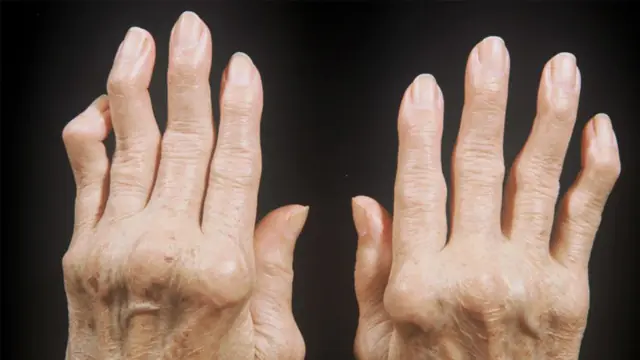
The processes of destruction of connective tissue go through several stages:
- mucoid (swelling forms, collagen fibers swell and split);
- fibrinoid (they wipe off collagen fibers and cell elements);
- granulomatous (granulomas form around dead tissue);
- sclerotic (sclerosation or destruction of connective tissue).
Each phase of rheumatism lasts 1-2 months, the entire cycle lasts about six months. In case of relapse, the already healed areas are destroyed.
The disease occurs in acute and chronic forms. The acute form is observed more often in children and adolescents under 20 years of age. The symptoms are similar to acute respiratory infections, but after a couple of days a rash and pain in the heart and joints appear. The chronic form is characterized by seasonal relapses.
If treatment is started in a timely manner, complications of rheumatism do not occur. But once the joints have already undergone deformation, it is impossible to return them to their original state. The patient is prescribed regular feasible physical activity, proper nutrition and compliance with preventive measures.
The most unfavorable outcome is progressive disease. There are often cases of relapse if the streptococcal infection occurs again. Then the disease is more acute and requires the use of strong drugs.
Lack of treatment leads to death of joint tissues and immobilization. Irreversible changes also occur in the heart. The most common complication is mitral valve prolapse, which leads to poor circulation and insufficient nutrition of the brain.
In advanced cases, the disease spreads to the blood vessels, skin, nervous system, and affects the bones of the neck and jaw. It becomes difficult for the patient to turn his head and even eat.
Reasons for the development of rheumatism
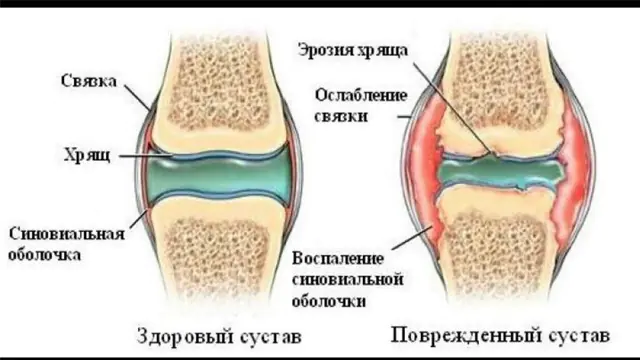
The causative agent of the disease is considered to be hemolytic streptococcus. If the infection remains in the body for too long, it spreads through the blood throughout the body, settling in the tissues of the heart and other organs along with antigens. Because the immune system recognizes streptococcus by certain molecules that are also found in the body, it launches an attack against its own cells and tissues.
Immunity to streptococcus is not developed. When the infection enters the blood again, a repeated immune response occurs and the disease worsens.
The cause of rheumatism is also the influence of additional factors:
- poorly treated pathologies caused by streptococcus (tonsillitis, scarlet fever, furunculosis, sinusitis, caries);
- heredity (when favorable conditions are formed, the mechanism for the development of rheumatism is triggered);
- viral diseases (frequent flu, ARVI, respiratory diseases);
- other joint diseases similar in etiology and symptoms (arthritis, arthrosis, chondrosis, osteomyelitis);
- hypothermia, bruises, injuries;
- diseases of the liver, endocrine system;
- poisoning with heavy metals, pesticides, radioactive compounds;
- diseases of the hematopoietic system.
If the disease is latent or sluggish, exacerbation may occur against the background of diabetes, asthma, pregnancy, or allergies.
Main symptoms of rheumatism
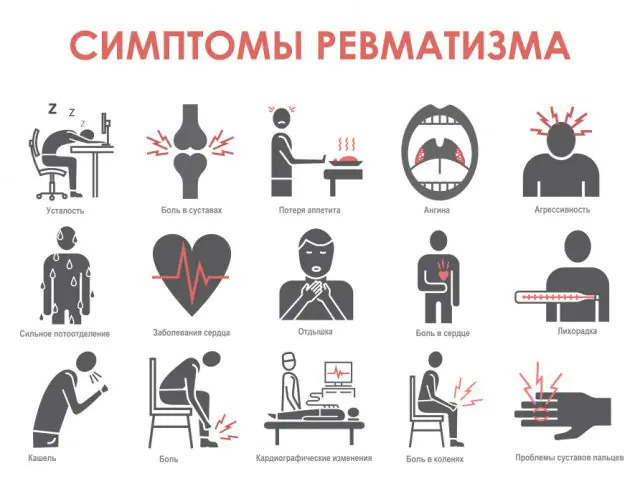
Signs of rheumatism make themselves felt by sharp joint pains. Sensations occur in large joints: shoulder, knee, elbow. The joint is hot to the touch, the skin on the affected area turns red. Compared to arthritis, a distinctive feature of rheumatism is increased pain during movement.
If the pathology progresses, the pain of rheumatism becomes more pronounced, and it is impossible to touch the joint. Body temperature rises to 39-40 degrees. If the heart is affected, shortness of breath, tachycardia, and right-sided chest pain during exercise are present.
The symptoms of rheumatism are mirrored: the disease affects 2 joints at once. Rarely is there a one-sided form. Another feature of pathology is volatility. If left untreated, more and more joints are affected. The disease can affect the spine and lower jaw.
The symptoms of rheumatism are less pronounced in older people, as well as those suffering from a chronic form of the disease. In these cases, the pain is not so severe, and the temperature rises slightly.
Important! If treatment is started after the first symptoms appear, changes in the connective tissue can be prevented.Methods for diagnosing rheumatism
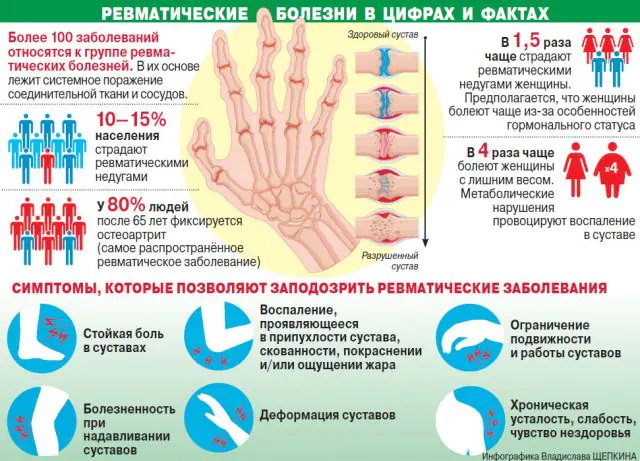
Rheumatism is treated by a rheumatologist or a more specialized specialist - an arthrologist. But if there is no such doctor nearby, consult a general practitioner. He will collect anamnesis and prescribe the necessary tests.
Diagnosis of rheumatism involves a number of laboratory and instrumental studies, without which it is impossible to differentiate the disease:
- general and biochemical blood test (analysis for rheumatism assumes the presence of a number of indicators characteristic of this disease);
- X-ray (the presence of chips and deformed areas indicates pathology);
- Ultrasound (a more accurate study that allows you to determine the localization of the source of inflammation, the phase of rheumatism);
- electrocardiogram (joint damage occurs due to deformation of cardiac tissue);
- throat culture (helps identify recent streptococcal infection);
- immunological analysis to detect antibodies.
Usually 2-3 indicators are enough to confirm rheumatism and prescribe treatment.
If diagnosis is difficult, additional studies are recommended:
- synovial fluid analysis;
- arthroscopy (instrumental visualization of the joint cavity);
- scintigraphy (analysis for the detection of a special substance in the joint - technetium);
- collection of material from the synovial membrane (biopsy);
- MRI (to detect joint deformities).
More detailed studies help to make a diagnosis with maximum accuracy.
Methods for treating rheumatism
In the acute stage, treatment of rheumatism occurs in a hospital under the supervision of a rheumatologist and cardiologist. The patient is prescribed bed rest and a diet with limited proteins and carbohydrates. Table No. 10 according to Pevzner is taken as a basis, with the exception of salted, fried and smoked dishes. How to treat rheumatism depends on the stage and form of the disease.
Medicines for the treatment of rheumatism

Treatment of rheumatism is complex and involves taking a variety of medications:
- penicillin antibiotics to suppress streptococci (Erythromycin, Ampicillin, price - 50 rubles or 20 hryvnia) for 15 days;
- non-steroidal anti-inflammatory drugs with an analgesic effect (Diclofenac, Ibuprofen, Nimesulide, Ketoprofen, price - 100 rubles or 40 hryvnia);
- glucocorticosteroids to relieve inflammation (Triamcinolone, Hydrocortisone, price - 200 rubles or 90 hryvnia);
- immunosuppressants (Chloroquine, Chlorbutin, price - 2000 rubles or 700 hryvnia);
- cardiac glycosides to maintain heart function (Digoxin, price - 100 rubles or 40 hryvnia).
Anti-inflammatory ointments Diclofenac and Hydrocortisone are prescribed as drugs for local treatment.
Note! When joints are affected by streptococcal infection, surgical intervention is rarely performed. Indications include severe heart defects and complete destruction of joint tissue. In this case, diseased areas are replaced with artificial materials or prosthetics.Physiotherapy for the treatment of rheumatism

In the photo there is magnetic therapy - magnetophoresis for the treatment of rheumatism
During the recovery period, patients are recommended a course of physiotherapy, which involves the following procedures:
- electrophoresis- introduction of medicinal substance ions into the body using a weak electric current;
- UHF- warming up the joints;
- paraffin applications- promote deep warming, improve blood circulation and tissue restoration;
- Exercise therapy- to prevent fusion of joints and limit their mobility, it is necessary to regularly perform simple exercises;
- laser therapy— used to relieve swelling and accelerate regeneration;
- massage- stimulates joint mobility, improves blood circulation.
If the pathology does not go away for a long time, plasmapheresis (blood purification) is performed. The procedure removes toxins from the body to reduce the load on the kidneys and liver.
Folk remedies against rheumatism
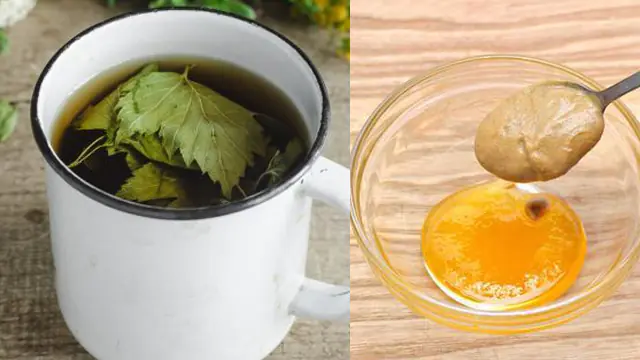
Recipes from traditional healers are aimed at increasing immunity and warming joints to improve blood circulation. However, they do not completely cure the disease, especially at an advanced stage. Traditional methods are good as a complement to traditional therapy and for prevention.
Effective recipes for treating rheumatism at home:
- Compress with salt. Dissolve 1 tbsp. salt in 1 tbsp. water. Soak a cotton cloth or bandage in saline solution and apply to the joint. Wrap the sore spot and keep the compress for 2 hours. Repeat the procedure twice a day.
- Decoction of currant leaves. Make a thick decoction by boiling the leaves for 10 minutes and leaving for 24 hours. Take a couple of tablespoons three times a day for a month.
- Ointment with mustard and honey. Take half mustard and honey. Mix the ingredients and add 1 tsp. salt and soda. Rub the mixture into the affected joints for 5 minutes. Rinse with water.
- Compresses with oats. Place the oats in a linen bag and cook until tender. Squeeze and apply to the joint. Wrap with a cloth and keep the compress for 2 hours.
To strengthen the immune system, traditional medicine advises eating sour berries (blueberries, cranberries, currants), and drinking lemon juice with water on an empty stomach in the morning.
How to treat rheumatism in children?
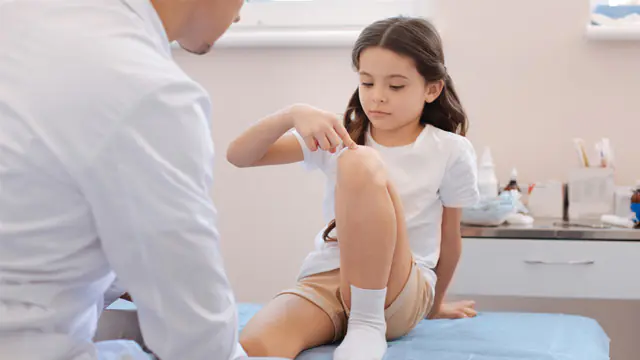
The pathology most often affects children aged 7 to 15 years, although preschoolers can also be susceptible to rheumatic attacks. The disease is not immediately detected: children rarely complain of heart pain, and parents sometimes do not take their words seriously.
If the heart is affected, the disease may not affect the joints. But if the infection has spread to the bone tissue, the child complains that from time to time one or another joint hurts. The baby becomes more passive and avoids active games, as movement entails pain.
Treatment of rheumatism in children in the active phase occurs in a hospital for 2 weeks. The child must observe strict bed rest. Then quiet games in bed are allowed, but the regime is maintained for another 3 weeks.
The treatment regimen for childhood rheumatism is almost no different from adult therapy, but the drugs are selected taking into account the patient’s age. Hormonal drugs are used in especially severe cases.
At the rehabilitation stage, children are prescribed to do therapeutic exercises, parents are advised to monitor their diet, and vitamin therapy is given. Subsequently, the child is observed by a doctor for a year, and long-acting antibacterial medications are taken to prevent relapses.
Prevention of rheumatism
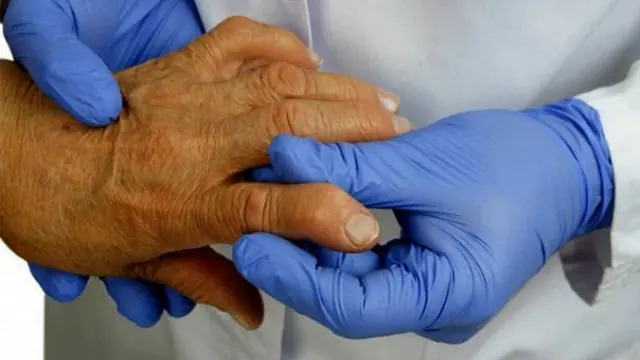
Not all people infected with streptococcal infection suffer from rheumatism as a complication after other diseases or injuries. The disease develops in only 2.5% of patients.
To avoid pathology, you must remember the rules for the prevention of rheumatism:
- play sports, giving the body feasible stress;
- maintain hygiene;
- to harden;
- avoid hypothermia;
- eat well;
- carefully treat diseases of the nasopharynx and bronchopulmonary pathologies.
If the disease recurs, be sure to take courses of antibiotics. If a patient develops heart failure and the joints are involved in the pathological process, he will have to follow preventive measures throughout his life.
Video about rheumatism:



